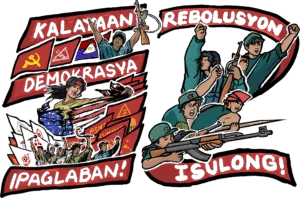Updated May 2006
Peace talks between the Government of the Republic of the Philippines (GRP) and the National Democratic Front of the Philippines (NDFP) were first conducted in August-December 1986 under the Aquino administration. After signing a 60-day ceasefire agreement, the GRP showed no more interest in discussing the substantive agenda. The talks collapsed after government troops fired on unarmed peasants demonstrating for land reform near the presidential palace, killing nineteen and injuring hundreds, in January 1987. On March 25, 1987, President Aquino unleashed the sword of war against the New People’s Army (NPA) and the revolutionary movement.
Updated May 2006
Peace talks between the Government of the Republic of the Philippines (GRP) and the National Democratic Front of the Philippines (NDFP) were first conducted in August-December 1986 under the Aquino administration. After signing a 60-day ceasefire agreement, the GRP showed no more interest in discussing the substantive agenda. The talks collapsed after government troops fired on unarmed peasants demonstrating for land reform near the presidential palace, killing nineteen and injuring hundreds, in January 1987. On March 25, 1987, President Aquino unleashed the sword of war against the New People’s Army (NPA) and the revolutionary movement.
Exploratory and Preliminary Talks (1988-1995)
August 14, 1988 – As goodwill measure, NDFP issues release order of five prisoners of war (POWs), four lieutenants and a sergeant, held by the NPA Melito Glor Command to GRP representatives after 60 days of detention
December 1988 – In an editorial in its official publication, Liberation, NDFP announces its openness to resume peace talks with GRP; in the spirit of the season, NDFP declares unilateral ceasefire effective December 24-26 and December 31-January 1; and, as goodwill measure, issues release order for six POWs held by the Melito Glor Command since September 25 to GRP representatives
February 1989 – Through chief international representative Luis Jalandoni, NDFP expresses willingness to start a new round of peace talks with GRP if the Aquino government makes an executive proclamation against the renewal of the bases agreement with the US on or before Sept. 16, 1991
July 12, 1990 – European Parliament passes a resolution condemning the Aquino government for its continuing human rights violations, demanding a stop to its total war policy, and recommending the withholding of bilateral aid to the Aquino government
July 21, 1990 – The NDFP declares a temporary unilateral ceasefire in earthquake-affected areas in Northern and Central Luzon and Metro Manila to ensure the speedy relief and rehabilitation of communities; unilateral ceasefire is lifted after two months
September 20, 1990 – NDFP chairman Manuel Romero, in a letter to GRP Pres. Aquino, reiterates NDFP’s long-standing offer for the reopening of formal talks between the GRP and NDFP, comprehensively laying down the NDFP’s strategic view of the peace talks; President Aquino responds positively
September 24, 1990 – NDFP representatives Luis Jalandoni and Coni Ledesma meet with a GRP delegation led by Gov. Bren Guiao in Singapore in informal discussions on the prospects of resuming the peace negotiations
September 26-29, 1990 – GRP emissary Rep. Jose Yap meets separately with NDFP vice chairman for international relations Luis Jalandoni and NDFP consultant Jose Ma. Sison in the Netherlands
October 4, 1990 – Luis Jalandoni and Jose Ma. Sison, and Rep. Jose Yap issue separate but similar statements announcing that prospects are bright for a new round of peace negotiations between the GRP and NDFP; Jalandoni declares that peace negotiations can start without preconditions
December 13, 1990 – European Parliament passes a resolution endorsing peace talks between the GRP and NDFP and encouraging both parties to negotiate and forge a comprehensive agreement for a just and lasting peace through the solution of basic national and social problems and, pending such, to agree on mutual respect for human rights in conformity with the humanitarian norms of war as established in the Geneva Convention and its protocols
August 15, 1991 – On behalf of the NDF National Council, Chairman Manuel Romero issues the NDFP Declaration of Adherence to International Humanitarian Law
September 5-6, 1991 – Discreet exploratory talks take place in Hongkong between NDFP representatives and a GRP mission
September 11, 1991 – NDFP declares a unilateral ceasefire to encourage the GRP Senate to reject a new treaty extending the stay of US military bases in the country
September 13, 1991 – The Swiss Federal Council acknowledges receipt of the NDFP Declaration of Adherence to International Humanitarian Law
September 17, 1991 – GRP Senate rejects new treaty extending stay of US military bases
September 21, 1991 – NDFP declares end to its unilateral ceasefire after GRP President Aquino withdrew the notice of termination already served on the US to close its military bases, and her failure to reciprocate the NDFP ceasefire declaration
August 29, 1992 – Rep. Jose Yap comes to the Netherlands with official written authority from newly-elected GRP President Fidel Ramos to resume official exploratory talks with NDFP.
September 1, 1992 – The Hague Joint Declaration is signed in The Hague, The Netherlands by NDFP vice chairman Luis Jalandoni and GRP emissary Rep. Jose Yap at the Clingendael, The Netherlands Institute of International Relations which receives support from the Dutch foreign affairs and defense ministries and advises the government and parliament on issues of international relations
September 14, 1992 – NDFP announces approval of The Hague Joint Declaration by newly-elected Chairman Mariano Orosa
September 16, 1992 – GRP forms the National Unification Commission with Haydee Yorac as Head; Yorac insists that talks between the GRP and NDFP be held in the Philippines, causing delay in the resumption of the preliminary talks
October 28, 1992 – GRP announces President Ramos’ approval of The Hague Joint Declaration
June 14, 1994 – The Breukelen Joint Statement is signed in Breukelen, The Netherlands
October 10-14, 1994 – GRP and NDFP negotiating panels meet in De Bilt, The Netherlands where:
- The NDFP protests the escalation of human rights violations by the GRP
- The two panels agree to appoint their respective “small committee” to draft the joint agreement on safety and immunity guarantees
- The GRP panel rejects the common draft drawn by the “small committees” of the two panels and unilaterally declares a collapse of the talks
November 1994 – The two panels agree to continue exchanging drafts of the agreement on security and immunity guarantees by fax
February 24, 1995 – The Joint Agreement on Safety and Immunity Guarantees (JASIG) is signed by the two panels in Nieuwegein, The Netherlands
The opening of formal peace negotiations is set on June 1, 1995 in Brussels, Belgium (the GRP panel subsequently requests to move the opening to June 26, 1995)
February 26, 1995 – The Joint Agreement on the Ground Rules of the Formal Meetings between the GRP and NDFP Negotiating Panels is signed in Nieuwegein, The Netherlands.
May 2, 1995 – The JASIG takes effect
May 17, 1995 – NDFP Panel consultant Sotero Llamas, who is under the protection of JASIG, is wounded and arrested by Armed Forces of the Philippines (AFP) troops in Juban, Sorsogon, and subsequently detained and charged with criminal offenses; NDFP demands his release in accordance with the JASIG.

